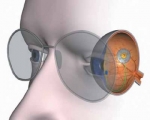Apr 21, 2006
Intelligent Medical Implants Reports Artificial Vision Breakthrough
"The provoked visual perceptions were pleasant, according to the patients, and this was the first time they had seen something in many years-- in one case, several decades. Understandably, they reacted emotionally to their visual experience."
Hans-Juergen Tiedtke
Chief Executive Officer
IIP-Technologies GmbH
IIP-Technologies GmbH, on behalf of its parent company Intelligent Medical Implants AG ("IMI") (www.intmedimplants.com), announced today that a limited clinical study related to its ongoing Early Human Trial has demonstrated that IMI's patented, first-generation Learning Retinal Implant(TM) enabled patients to see light - as well as simple patterns - via a wireless transmission of data and energy. This is the first time in the history of the development of artificial vision that completely wireless transmission of data and energy into an implant in the eye of long-time blind persons has resulted in pattern recognition.
 The Learning Retinal Implant has been successfully implanted in four patients for a duration of up to 13 weeks to date (the first implantation occurred in late-November 2005). Subsequent clinical testing of the IMI device with these patients commenced on schedule beginning in January 2006 at the University of Hamburg (Germany) Medical School under principal investigator Prof. Gisbert Richard, Professor of Ophthalmology. Each of the implantations has been "extremely well-tolerated" and fixation of the implant has been "stable, with no inflammatory reactions," according to Prof. Richard.
The Learning Retinal Implant has been successfully implanted in four patients for a duration of up to 13 weeks to date (the first implantation occurred in late-November 2005). Subsequent clinical testing of the IMI device with these patients commenced on schedule beginning in January 2006 at the University of Hamburg (Germany) Medical School under principal investigator Prof. Gisbert Richard, Professor of Ophthalmology. Each of the implantations has been "extremely well-tolerated" and fixation of the implant has been "stable, with no inflammatory reactions," according to Prof. Richard.
"Each of these blind persons had no visual perception at all, yet upon wireless stimulation of the retina via the Learning Retinal Implant, they were able to 'see' something,"said Hans-Juergen Tiedtke, CEO of IIP-Technologies, a subsidiary of IMI. "One patient, for example, a 65-year-old female from Marienberg, Germany, has not had sight for more than a half century. From early childhood she has suffered from RP, meaning that she has not seen normally for more than 60 years. Nevertheless, in her first pattern recognition test, she described continuous objects such as a half circle. There is no doubt that this result is extremely positive, given that she has had no sight for almost her entire life, yet was still able to immediately receive a visual perception from electrical stimulation.

"While further clinical testing is needed and planned, we are truly delighted by these early results. It is our expectation that, in the not-too-distant future, our Learning Retinal Implant System, along with rehabilitation, may allow patients to recognize objects by identifying their size, as well as their position, movements and shapes. In other words, a blind person, using our Learning Retinal Implant System, is expected to be able to move independently in an unfamiliar environment--thus enabling him or her to lead an autonomous life. Indeed, development of a wireless visual prosthesis that could be implanted permanently with good results is the 'Holy Grail' of artificial vision," added Mr. Tiedtke.
IMI's initial clinical-indication focus is blind persons with Retinitis Pigmentosa ('RP'), one of the two most common causes of vision loss in persons over the age of 50 by hereditary degenerative retinal diseases. RP is considered irreversible, and no treatment or cure is known to date. Several million people are affected worldwide.
13:30 Posted in Brain training & cognitive enhancement | Permalink | Comments (0) | Tags: Positive Technology







The comments are closed.